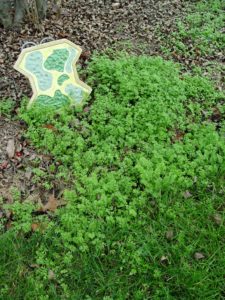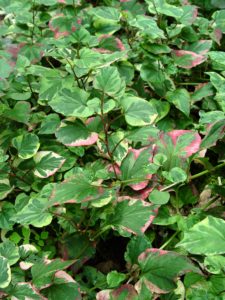Fixing a “Messy” August Garden
August 16th, 2022
Gardens can still look reasonably good this time of year if you’ve stayed on top of maintenance, policed for pests, and kept things watered.

August gardens sometimes can look a bit, well, “unkempt.”
However, strings of 90-degree days and other life matters have a way of eating into garden care, leading to August yards that, well, aren’t always at the top of their game.
No need to give up and pull the shades until frost, though. The situation might look worse than it really is.
A few hours of focused course corrections can bring many botanical messes back into quick order.
Seven issues and how to fix them:
Floppy plants
Staking known floppers like sedum and asters from the outset is the best strategy, but if you didn’t do that, corral them now by inserting three bamboo stakes around plants and tying them with green jute into a “straitjacket.”
Flopping perennials that already have bloomed can be cut back or cut down nearly to the ground, especially ones that have browned or been attacked by bugs or disease. (Catmint, daylilies, iris, peonies, salvia, yarrow, and beebalm are good examples.)
“Dead-heading”
This gardening term means pinching, snipping, or pruning off old flower heads after they’ve finished blooming.
This not only neatens the garden quickly but may encourage the plant to rebloom. It also keeps plants from wasting energy growing seeds that you don’t want.
Dead-heading makes the most noticeable difference on big-petaled species and/or species that hold their flowers high on the plant, such as roses, hardy hibiscus, peonies, coneflowers, and tall garden phlox.
Unwanted seeding
You may want some plants to drop mature seed (larkspur, petunias, or cosmos, for example), but others can produce so many seeds that they cross over into weediness.

A nigella plant from the year before has produced this many new seedlings the following season.
Cleome, nigella, campanula, and morning glory as well as invasive shrubs, such as burning bush, rose-of-sharon, barberry, and most butterfly bush varieties come to mind.
Dead-heading solves this one, too. You’ll just have to be vigilant enough to snip all of the spent flowers before their seeds mature… and remember that some plants keep trying to produce mature seeds all season, not just all at once.
A backup plan is laying a fresh coat of mulch next spring to discourage the sprouting of fallen seeds that you didn’t snip.
Ratty leaves
Bugs, diseases, and heat take their toll by mid-summer, causing spotted and streaked leaves, leaves that are browning and curling, and leaves that are chewed or holey.
Examples include leaf streak on daylilies, powdery mildew on phlox and beebalm, Japanese-beetle chewing damage on roses, and leaf spotting on black-eyed susans and hydrangeas.
Most leaf damage is cosmetic and temporary, but it can make a garden look bad in the short term.
Since brown or badly damaged leaves are doing the plant little good anyway, snip off ratty foliage as you see it.
Ditto for foliage that’s been fried to a crisp by heat and dry soil, such as astilbes, ferns, and hostas.
Remove diseased leaves from the garden since that removes disease spores that could cause a reinfection later.
Fresh new foliage often emerges once the damaged leaves are gone, especially after a soaking rain or a good watering.
De-jungling
Some plants are more vigorous than others and by now have creeped into areas where you don’t want them. Examples of frequent invaders include ivy, bishop’s weed, ribbon grass, ajuga, chameleon plant, spiderwort, gooseneck loosestrife, lilies-of-the-valley, beebalm, and sweet woodruff.

The chameleon plant (Houttuynia) might look pretty, but it spreads with a vengeance.
It’s best to set your boundaries and keep aggressive plants from encroaching them, but if any plants are now out of control, dig or clip ASAP before they go any further. You’re unlikely to kill any of the above by pruning.
Don’t feel bad about throwing healthy shoveled pieces onto the compost pile. Think of it as “building future soil.”
Out-of-shape plants
Your trees, shrubs, and evergreens may have grown too big or in a gangly shape by now if you haven’t been paying attention.
Summer is fine for most neatening work – usually. However, plants that are under heat and drought stress are best left alone.
Unless we get some good soaking rains and cooler temperatures in August, skip even light pruning until next year. Reason: Wounds create more moisture loss on woody plants and divert survival energy into healing and trying to grow replacement leaves and stems.
In normal growth times, make light summer cuts right above a branch or bud that’s facing the direction you want. This controls shape and is especially important in a tree’s early years.
Hedge plants such as boxwoods, hollies, arborvitae, and yews normally can be trimmed in July or August, too.
Just get all pruning done by Labor Day since early to mid-fall is the worst time to cut anything.
It’s OK even in hot, dry weather to snip potted flowers in cases where one or two varieties are overly dominating the rest.

These are “suckers” coming out from around the base of an apple tree.
Suckers
Suckers are shoots that pop up from the roots around shrubs (Virginia sweetspire, sweetshrub, summersweet, fothergilla, etc.) or from around trees (crabapple, cherry, pear, etc.)
For attached suckers coming up around the base of trees, use pruners or loppers to cut them off as close to the ground as possible. These are just wasting the tree’s growth energy.
For shrubs sending runners into unwanted territory, wait until early fall or at least until we get a soaking rain or two, then use a shovel to cut them off where you want the colonization to stop. Rooted pieces of these pulled-up runners can be transplanted, if you want. Otherwise, toss them.
More than 200 pages of when-to-do-what tips are in my Cool Springs Press book, “Pennsylvania Month-by-Month Gardening,” available for $24.95 (plus $4 shipping) on my Buy Helpful Info page.







